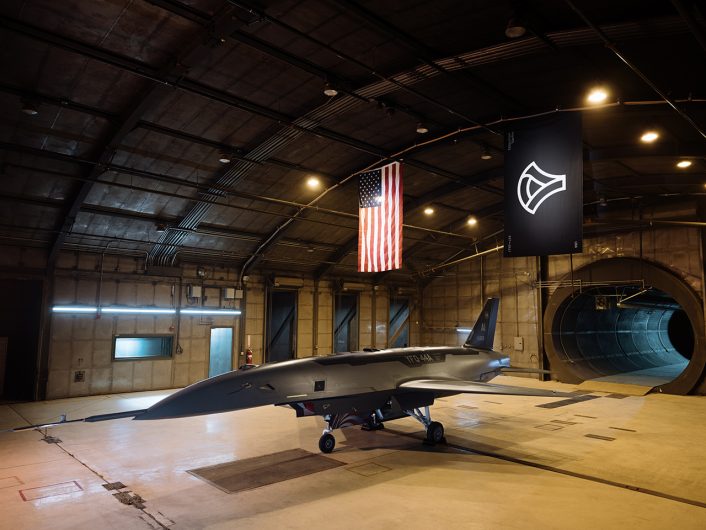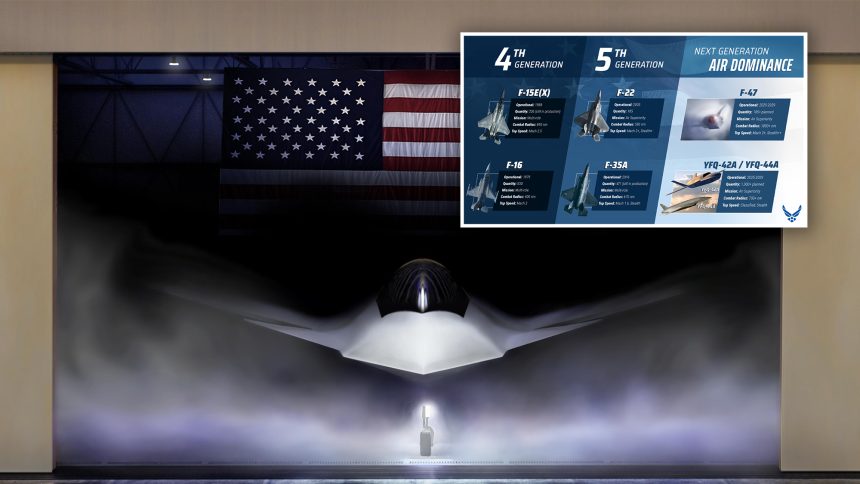The USAF Chief of Staff posted a graphic featuring the Boeing F-47 stating the aircraft will be in service in the 2025-2029 timeframe with 185+ units planned.
Chief of Staff General David Allvin shared the graphic on X/Twitter on May. 13, 2025, commenting that the U.S. Air Force “will continue to be the world’s best example of speed, agility, and lethality.” As well as listing the expected timeframe for the Boeing F-47’s operational deployment and the planned procurement numbers, it also shows the aircraft’s combat radius as in excess of 1,000 nautical miles – well beyond that of the F-35, F-22, and F-15EX.
Our @usairforce will continue to be the world’s best example of speed, agility, and lethality. Modernization means fielding a collection of assets that provide unique dilemmas for adversaries—matching capabilities to threats—while keeping us on the right side of the cost curve. pic.twitter.com/vqjxCdBYid
— General David Allvin (@OfficialCSAF) May 13, 2025
Though the timeframe of 2025-2029 for service entry is an ambitious one, we do not know how strictly the term ‘operational’ in this context is intended to apply. Previous statements, including ones made during the official announcement of the aircraft, stated that the F-47 was planned to fly before the end of President Trump’s term in 2029. Whether the dates in this graphic refer to this, or rather to a more ambitious goal of actually entering operational service remains to be seen. Almost a decade ended up separating the F-35’s first flight and its entry into operational service.
We know that prototype examples of manned NGAD designs have been flying for some time, but the production airframes themselves will likely feature quite heavily evolved designs.
A production run of 185+ aircraft is in fact slightly down from USAF plans released before the fighter contract was awarded. However, with rapidly changing requirements and continual assessment, it is likely this figure will remain flexible. The Air Force may be wary of such a low figure following its struggles with the F-22 Raptor, whose production ended up being capped around the same figure. Subsequently, airframe attrition, damage from weather events, and the requirement for aircraft to be rotated through overhaul, trials, and upgrade processes have left the service short of its prized fighter.
F-22 first flew 1997 entered service Dec 2005 as F-22A. USAF originally planned total of 750, program cut to 187 aircraft 2009 due high costs, lack of air-to-air missions at time of production, and development more affordable and versatile F-35. last aircraft delivered in 2012. pic.twitter.com/C50wAySkKs
— Chris Bolton (@CcibChris) April 24, 2024
With a combat radius of over 1,000 nautical miles, the F-47 would have an exceptional range besting anything else of its type in the U.S. Air Force’s inventory. After initial renderings were released, some predicted based on what was seen that the aircraft would not focus on range or payload and instead sacrifice these for maneuverability. While we are still yet to see how exactly these differing performance characteristics are balanced, if the combat radius figure holds the F-47 would offer a considerable long-range strike function and additionally reduce the burden on the Air Force refueling fleet.
In the graphic, we also see the U.S. Air Force making a rare classification of levels of stealth capability. At the lowest end, the F-35, listed as simply a stealth aircraft. The F-22, which unlike the F-35 did not have to take overseas sales into account, is listed as “Stealth+”, while the F-47 presumably tops the chart with a “Stealth++” label. It is not surprising that the new aircraft features a greater stealth capability than those that came before, and these arbitrary labels tell us very little about the actual figures involved. Nonetheless, the different capabilities being represented in this graphic is interesting to note.
Collaborative Combat Aircraft
Alongside the Boeing F-47 in the Next Generation Air Dominance (NGAD) category are the YFQ-42A and YFQ-44A unmanned jets. These aircraft, from Increment 1 of the Collaborative Combat Aircraft (CCA) contract, are designed to work closely in tandem with sixth generation aircraft like the F-47 in order to provide force multiplication with additional payload capacity, sensor picket capabilities, and decoy missions.

The top speed for these airframes is listed as classified, and both are noted to feature stealth capabilities. As smaller aircraft, a smaller combat radius compared to the F-47 is unsurprising, but 700+ nautical miles still puts them well in excess of many existing U.S. tactical fighters.
Over 1,000 of these unmanned aircraft are planned, with an operational date also listed as 2025-2029. Fielding these CCAs with the F-47 from the start would be logical given how much each system is said to leverage the other, with the NGAD program itself being an overall initiative including manned and unmanned aircraft, rather than a specific individual aircraft.
“For the first time in our history, we have a fighter designation in the YFQ-42 Alpha and YFQ-44 Alpha,” ~ Chief of Staff Gen. Dave Allvin
F designation for Fighter, Q for drone, Y for prototype. After one of em is selected & enters prod, it’ll be just FQhttps://t.co/8TYzcihVcq https://t.co/ODBriUiuOq pic.twitter.com/uuqeEqvCA8
— Doha (@Doha104p3) March 11, 2025
The significantly higher proportion of CCAs vs manned aircraft reflects their status as less expensive and more attritable airframes. Without a pilot on board, they can be sent into heavily contested airspace and perform missions without the risk of losing lives if successfully engaged by hostile aircraft or air defense.









